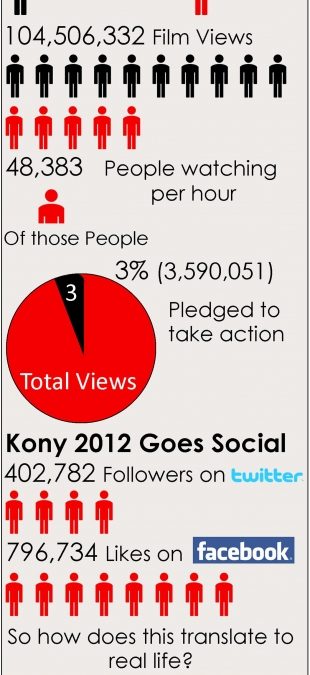
Solid State Hard Drives – Are They Worth It?
October 16, 2012
Google Finally Unlocks Its Data Center Doors
October 17, 2012On March 5, 2012 a video was released that reached historic proportion. The world heard about Kony 2012, Invisible Children, and the nightmares taking place in Uganda
UPDATE on Kony 2012:
For almost 8 months now, Invisible Children has tried to illuminate the injustices taking place in Uganda. Even with countless videos, social media accounts, and news coverage, most would say Kony 2012 has failed.
That was until yesterday.
On October 15th, the new video Move debuted. Yet again, Invisible Children is trying to rally up Milennials (young adults), to take action. The 30-minute video ends with a call to action: meet in Washington D.C. on November 17th, get leaders to listen, and make a difference. Simple enough, right? If the previous campaign, Cover the Night, is any indication of the impact this will make – we are in trouble.
Then again, as I said the first time around, it is better try and help then do nothing at all. Take some time out of your day, check out the new Move video or the shorter version, Move DC. What do you think, are we a slinky?
Kony 2012: Will it Cover the Night? (original post below)
On March 5, 2012 a historic video was released. The world, in masses, heard about Kony 2012 and children soldiers for the first time. For most, it was also the first time hearing about the terrible and shocking injustices taking place in Uganda and about the organization Invisible Children.

The news spread wide and quick. Within the first few days on the web, the story about the atrocities committed by Kony, the rebel leader of the Lord’s Resistance Army (LRA), went viral. To be more specific: after the first 45 days of its release, the video had 104,506,332 views. The video was so persuasive that 4 million peopled pledged, “to help make Joseph Kony famous by watching and sharing KONY 2012.” The pledged “will use [their] voice to influence cultural and policy makers to raise the profile of the conflict. [They] will Stop at Nothing.” If you somehow missed out on the this historic viral video because perhaps your computer had a virus or you were locked in a bubble for a couple weeks, here is what it is all about:
Invisible Children strives to use “film, creativity, and social action to end the use of child soldiers in Joseph Kony’s Rebel War.” Their recent videos seem to do just that, urge others to take a stand and demand the capture of Kony. Joseph Kony, the rebel leader of the Lord’s Resistance Army (LRA), is known for his brutal tactics and the abduction of nearly 30,000 children in northern Uganda; a problem that became visible in large part due to the founders of Invisible Children and their friend Jacob.
So far, the campaign, cleverly named Kony 2012 for the symbolic likeness to presidential campaigns, has nearly 800,000 likes on Facebook plus 400,000 followers on Invisible Children’s Twitter. With nearly 50,000 people on the site at any one time (that’s a lot of traffic) Kony 2012 has gone viral. But the video does want viewers to stop there. The Invisible Children have attempted to take their online marketing strategy to ‘the streets.’ On April 20, 2012 Invisible Children wants to, “earn the right to be heard by our global leaders by serving our local communities. And above all, we will prove that our liberty is bound together,” and Cover the Night with Kony 2012. Kony 2012 posters, yard signs, billboards, building drops, skywriting, crop circles, laser graffiti, blimps, covered sports field, magazine inserts, and murals will hopefully ‘Cover the Night’ in every major city. Led by Invisible Children, ‘pledgers’ have been encouraged to reach out to UN and African Union leaders, key world leaders, and ‘head of states’ of countries to arrest Kony and join in the fight to stop children soldiers.
Unfortunately, the impact remains to be seen. In the past week, Los Angeles has yet to be ‘covered’ by Kony 2012. Looking down on one of the major streets in Los Angeles and not one Kony 2012 sign or poster is visible. This begs the question, has Invisible Children done enough to make it in the real’ world? Pledging something online is very different then engaging in the streets. As one person stated, ‘what good is a pot of gold to the fat leprechaun if he can’t get the dough to the other side of the rainbow?’ In other words, what good is it to have 100 million video views, 800 thousand Facebook likes, and 400 thousand Twitter likes if does not translate into change in the real world? The question may remain unanswered for a while. Either way, here is what you should do now: If you haven’t watched the video, watch it. If you haven’t pledged, pledge. If you pledged, make it count and Cover the Night. At the end of the day, it is better to have helped then do nothing at all and, the fact still remains, without these viral videos 30,000 children would still be unknown.


1 Comment
Thank you for sending this! When I originally saw the video I was in a graduate level class on social enterprises. My cohort and I discussed the impact of the film, the pros and cons, and how Ugandans would take it. Unfortunately, this news does not surprise me. In regards to Invisible Children and making a profit, I don’t think that was their main goal. I have known about Invisible Children since they started when a friend of mine brought the cause to our school and helped raise a fine penny for them. They are a great organization with a great marketing strategy. Now was what they did correct, that is based on your own opinion. What is for certain is that they provided information on a less-known problem facing global citizens. The ultimate question still remains, will the means justify the end result?